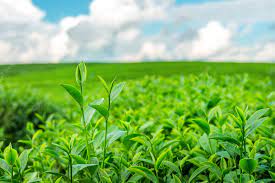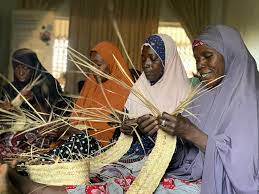
Tea (Camellia sinensis L.) production in Nigeria started in 1982 on commercial basis, the initial planting materials having been brought in from Cameroun and Kenya at various times. Production of tea in Nigeria takes place on the Mambilla Plateau in Taraba State located between 6~ and 7~ and long 9°E and 11°E.
Tea farming has been a long-standing agricultural practice, but in recent years, Nigeria has emerged as a potential hub for tea production. With its suitable climate, fertile soil, and growing demand for high-quality tea, the country offers an excellent opportunity for individuals interested in starting a tea farming venture.
In this comprehensive guide, we will explore the step-by-step process of initiating and managing a successful tea farm in Nigeria.
Conducting Feasibility Studies and Market Research: Before diving into tea farming, it is crucial to conduct feasibility studies and thorough market research. This step will help you understand the tea industry in Nigeria, identify potential competitors, assess market demand, and determine the profitability of your tea farm. Engage with local tea farmers, visit existing tea plantations, and consult with agricultural experts to gather valuable insights.
Climatic Conditions for Tea Farming
Temperature: Tea plants thrive in regions with moderate to cool temperatures. In Nigeria, tea cultivation is primarily suitable in highland areas with elevations ranging from 1,200 to 2,000 meters above sea level. The ideal temperature range for tea farming is between 10°C and 30°C, with a mean annual temperature of around 20°C being optimal. These moderate temperatures promote the growth of tea plants and ensure the production of high-quality leaves.
Rainfall: Adequate and well-distributed rainfall is essential for tea cultivation. The recommended annual rainfall for tea farming in Nigeria is between 1,500 and 2,500 millimeters. The rainfall distribution should be evenly spread throughout the year to avoid prolonged dry spells or excessive moisture during the growing season. High humidity levels, often associated with regions receiving abundant rainfall, are also beneficial for tea plants.
Sunlight: While tea plants require a significant amount of sunlight, they also benefit from partial shade. In Nigeria, tea cultivation should ideally be located in areas with good exposure to sunlight, but where there is some protection from the scorching heat of direct sunlight. This can be achieved by selecting sites with partial shade from trees or by creating artificial shade using shade nets. Proper shading helps regulate temperature and prevents the tea leaves from wilting.
Soil Requirements for Tea Farming
Soil Type: Tea plants prefer well-drained soils with good moisture retention capabilities. The most suitable soil types for tea farming in Nigeria are deep, friable soils with a pH level between 4.5 and 6.5. These soils should have good organic matter content, allowing for proper nutrient absorption and root development. Clayey or sandy loam soils are considered ideal for tea cultivation as they offer a good balance of drainage and water-holding capacity.
Soil Fertility: Maintaining soil fertility is crucial for the successful growth of tea plants. Regular soil testing is recommended to determine the nutrient content and pH level of the soil. Tea plants require essential nutrients such as nitrogen, phosphorus, and potassium for healthy growth. Additionally, organic matter, obtained from compost or well-rotted farmyard manure, should be incorporated into the soil to improve its fertility and structure.
Soil Drainage: Proper soil drainage is essential to prevent waterlogging, which can lead to root rot and other diseases. Tea plants are susceptible to waterlogged conditions, so it is important to ensure that the soil has good drainage capacity. If the soil is poorly drained, implementing measures such as contour plowing, terracing, or installing drainage systems can help mitigate the risk of waterlogging.
Soil Erosion Control: Preventing soil erosion is crucial for maintaining the long-term sustainability of tea plantations. Conservation practices such as contour plowing, mulching, and establishment of windbreaks can help reduce soil erosion. These practices also help to preserve soil moisture and organic matter, creating a favorable environment for tea plants to thrive.
Selecting the Suitable Tea Varieties
Nigeria offers diverse agro-climatic zones suitable for tea farming, such as Plateau, Mambilla, and Obudu. Depending on your specific location, choose tea varieties that thrive in the prevailing climatic conditions. Some popular tea varieties suitable for Nigeria include Camellia sinensis (Chinese tea), Camellia assamica (Assam tea), and Camellia cambodiensis (Cambodian tea).
Camellia sinensis: The Chinese Tea
Camellia sinensis, originating from China, is the most widely recognized tea variety and serves as the foundation for various types of tea worldwide. It is a versatile plant with several sub-varieties, each offering distinct flavors and aromas. In Nigeria, Camellia sinensis thrives in favorable climatic conditions, particularly in high-altitude regions. Some notable sub-varieties include:
a) Green Tea: Known for its vibrant green leaves and delicate taste, green tea is produced by quickly steaming or pan-frying the leaves to halt oxidation. Nigerian green tea is celebrated for its grassy, refreshing flavor and abundant antioxidants.
b) White Tea: Renowned for its minimal processing, white tea is made from young and tender tea leaves. These leaves are gently withered and dried, resulting in a subtle, delicate flavor with natural sweetness. Nigeria's white tea exhibits floral notes and a mild, soothing character.
c) Oolong Tea: Partially fermented, oolong tea occupies the middle ground between green and black tea. The leaves undergo intricate processes of withering, rolling, and oxidation. Nigerian oolong tea captivates with its smooth texture, fruity undertones, and rich aroma.
Camellia assamica: The Assam Tea
Camellia assamica, native to the Assam region of India, thrives in the tropical climate of Nigeria, particularly in the southern regions. Known for its larger leaves and robust flavor profile, this variety plays a significant role in Nigerian tea farming. Notable characteristics include:
a) Black Tea: Camellia assamica is renowned for its contribution to the world of black tea. The leaves are fully oxidized, resulting in a robust, full-bodied infusion. Nigerian black tea from Camellia assamica offers a deep, malty flavor with hints of fruitiness, making it an excellent choice for a bold morning cup.
Camellia cambodiensis: The Cambodian Tea
Camellia cambodiensis, also known as the Cambodian tea, is a less well-known variety but carries its own unique charm. While not as widely cultivated as its Chinese and Assam counterparts, it has the potential for growth in Nigeria's tea industry. Key features include:
a) Herbal Infusions: Unlike the traditional tea varieties, Camellia cambodiensis is often used to produce herbal infusions. The leaves and flowers of this variety offer a diverse range of flavors and health benefits. From calming chamomile-like brews to invigorating floral concoctions, Nigerian herbal teas derived from Camellia cambodiensis provide a refreshing alternative to the more common tea varieties.
Acquiring Land and Preparing the Site
Once you have selected the tea varieties, the next step is to acquire suitable land for your tea farm. Look for land with well-drained soil, preferably slightly acidic (pH 5.5-6.5), and adequate sunlight exposure. Prepare the land by clearing vegetation, removing stones, and leveling the ground. Implement proper irrigation systems to ensure adequate water supply for the tea plants.
Sourcing Quality Planting Materials
To ensure the success of your tea farm, it is crucial to source high-quality planting materials. Obtain tea seedlings or young plants from reputable nurseries or agricultural research institutions. Carefully handle the plants during transportation to prevent damage. If possible, opt for clonal tea plants, as they offer improved yield and disease resistance.
Planting and Maintenance
Plant the tea seedlings or plants during the rainy season, preferably in well-prepared pits or trenches. Maintain proper spacing between plants to allow ample sunlight and airflow. Regularly weed the tea plantation to prevent weed competition. Implement a suitable fertilization and pest control strategy as per the recommendations of agricultural experts. Prune the tea bushes regularly to promote new shoots and maintain plant health.
Pests and Diseases
Pests in Tea Farming
Tea Mosquito Bug (Helopeltis spp.): The tea mosquito bug is a major pest in tea plantations, causing significant damage to young leaves and buds. These bugs extract sap from the plant tissue, leading to shriveled and deformed leaves. Integrated pest management (IPM) techniques, such as regular monitoring, proper sanitation, and the use of botanical and chemical insecticides, can help control this pest effectively.
Red Spider Mite (Oligonychus coffeae): The red spider mite is a tiny pest that thrives in hot and dry conditions, making it a common problem in tea farming. Infestation by this pest leads to the appearance of yellow spots and fine webbing on the leaves. Maintaining appropriate humidity levels and implementing biological control methods, such as predatory mites and insecticidal soaps, can help manage this pest.
Tea Green Leafhopper (Empoasca spp.): The tea green leafhopper is a sap-sucking insect that causes extensive damage to tea bushes. It injects toxic saliva into the plant, resulting in characteristic white streaks on the leaves, known as hopper burn. Cultural practices like proper pruning and regular weeding can aid in reducing the population of this pest. In severe cases, the use of chemical insecticides may be necessary.
Tea Tortrix (Homona coffearia): The tea tortrix is a caterpillar that feeds on tea shoots and young leaves, causing defoliation and stunting of plant growth. Monitoring for early signs of infestation and implementing pheromone traps and biological control agents can help prevent the spread of this pest. If necessary, targeted application of insecticides may be required.
Diseases in Tea Farming:
Tea Blister Blight (Exobasidium vexans): Tea blister blight is a fungal disease that affects the leaves and young shoots of tea plants. It manifests as blister-like eruptions on the leaf surface, leading to reduced photosynthesis and overall plant health. Cultural practices, including proper sanitation, removal of infected leaves, and the use of fungicides during favorable weather conditions, can help manage this disease effectively.
Tea Anthracnose (Colletotrichum spp.): Anthracnose is a fungal disease that affects various parts of the tea plant, including the shoots, leaves, and berries. It causes dark lesions and necrosis, leading to yield loss and reduced quality. Fungicide applications during favorable weather conditions, crop rotation, and removal of infected plant material are vital for controlling this disease.
Brown Root Rot (Phellinus noxius): Brown root rot is a destructive disease affecting the roots and stems of tea plants. Infected plants exhibit stunted growth, yellowing of leaves, and eventually, death. Proper land preparation, selection of disease-resistant varieties, and practicing crop rotation can help prevent the spread of brown root rot. Additionally, the use of biological control agents and soil amendments can be beneficial.
Harvesting and Processing
The first harvest generally begins two to three (2-3) years after planting, depending on the tea variety and yield of about one thousand to one thousand, five hundred (1,000 - 1,500) kilograms per hectare. Harvest the tea leaves when they reach their optimum size, which varies according to the type of tea being produced (green, black, or oolong).
The plucking process should be done meticulously to preserve leaf quality. After harvesting, the tea leaves undergo several processing steps, including withering, rolling, oxidation, and drying, which vary depending on the type of tea.
Marketing and Selling
Develop a marketing strategy to promote your tea brand and target potential buyers. Establish partnerships with tea distributors, wholesalers, retailers, and tea houses. Participate in trade fairs, exhibitions, and local markets to showcase your tea products. Utilize digital platforms and social media to create brand awareness and reach a wider customer base. Offer product samples and conduct tasting sessions to attract customers and gain their trust.
Continuous Learning and Improvement: Tea farming is an evolving industry, and it is essential to stay updated with the latest agricultural practices, tea processing techniques, and market trends. Engage in workshops, seminars, and training programs related to tea farming.
Collaborate with other tea farmers, agronomists, and researchers to exchange knowledge and experiences. Regularly assess and evaluate the performance of your tea farm, making necessary adjustments for improved productivity and quality.
In conclusion, starting a tea farm in Nigeria can be a rewarding and profitable venture. However, it requires careful planning, diligent execution, and continuous learning. By conducting thorough research, selecting suitable tea varieties, acquiring quality planting materials, and implementing proper farming and processing techniques, aspiring tea farmers can establish successful tea plantations in Nigeria.
With the growing demand for tea both domestically and internationally, this industry holds immense potential for entrepreneurs to contribute to Nigeria's agricultural growth and meet the rising demand for high-quality tea.






















